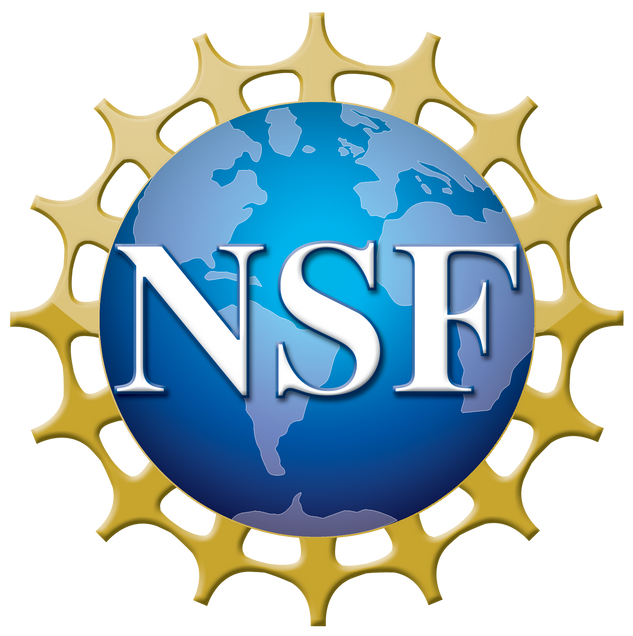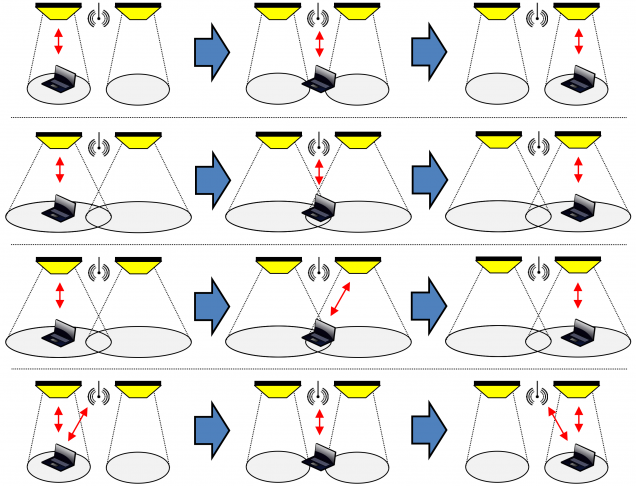Coexisting Radio Frequency and Optical Wireless Directional Small Cells (CROWD Networks)
 In this project we seek to use untapped optical wireless (OW) spectrum and the high areal spectral efficiency of directional small cells (DSCs) to augment existing RF small cells (RFSCs) to realize new levels of performance in future dense networks. In the proposed Coexisting RFSC and Optical Wireless DSC Network (CROWD), the optical DSC is used to offload high-speed downlink traffic from the RFSC while the RFSC provides coverage for highly mobile devices and devices without a reliable DSC connection. CROWD is intended to realize performance gains in wireless throughput, latency, and streaming performance. Outcomes of the work include: (1) analysis and simulation of heterogeneous CROWD networks under varying user traffic and mobility models, (2) a design framework and methodology for the creation and adoption of CROWD networks for future 5G systems, and (3) a functional proof-of-concept implementation in our existing testbed suitable for validation of the analytic and simulation results and as a blueprint for scale up.
In this project we seek to use untapped optical wireless (OW) spectrum and the high areal spectral efficiency of directional small cells (DSCs) to augment existing RF small cells (RFSCs) to realize new levels of performance in future dense networks. In the proposed Coexisting RFSC and Optical Wireless DSC Network (CROWD), the optical DSC is used to offload high-speed downlink traffic from the RFSC while the RFSC provides coverage for highly mobile devices and devices without a reliable DSC connection. CROWD is intended to realize performance gains in wireless throughput, latency, and streaming performance. Outcomes of the work include: (1) analysis and simulation of heterogeneous CROWD networks under varying user traffic and mobility models, (2) a design framework and methodology for the creation and adoption of CROWD networks for future 5G systems, and (3) a functional proof-of-concept implementation in our existing testbed suitable for validation of the analytic and simulation results and as a blueprint for scale up.

Example of a CROWD network comprised of RF and Optical Wireless access points
The project is expected to realize a new operating point for hybrid, heterogeneous networking with RF and optical wireless physical layers. We anticipate discovering the critical intersection of cell size and handover properties (latencies, transition thresholds) for indoor mobile data consumption under realistic use cases. Although much work exists for RF small cells, WiFi characterization, or handover; the nature of providing seamless data delivery for a mixed mode of sub-meter cells with directional and omnidirectional network overlays is new territory anticipated for directional media such as visible light communication or LiFi. The work is expected to provide a framework for the analysis and study of future heterogeneous network behavior that is anticipated as the OW medium continues to expand toward THz speeds. The unique combination of skills of the research team supports achieving the proposed goals.
The availability of spectrum for wireless communications has been identified as a critical enabler to growth in GDP; the proposed work seeks to exploit an alternative to the crowded RF arena to enable a new direction of research to realize untapped spectrum capacity. This capacity will permit the expanded capability of mobile wireless devices to continue to evolve, leading to enhances in many applications supporting quality of life, energy conservation, safety, and productivity that are derived directly from continuously-connected wireless devices. We also anticipate influencing the development of the 5G agenda and adopted standards including the IEEE as the role of heterogeneous networks. The proposal includes educational activities that complement the proposed research, including mentoring female and under-represented students through the prestigious McNair fellowship, developing an interdisciplinary Massive Open Online Course (MOOC) as a high-school STEM attractor, and development of curriculum for several courses.
This project involves collaborators from Boston University, the New Jersey Institute of Technology, the University of Albany, Chicago State University, and the University of Massachusetts, Boston, focused on how future 5G systems will need to support and manage multiple communications media including existing RF-based WiFi, future mm-Wave, and wireless optical systems. The project is supported by the National Science Foundation under Grant No. CNS-1617924.

Myriad instances of handover between access technologies in a CROWD network
Publications
- S. Shao, A. Khreishah, and I. Khalil “Enabling Real-time Indoor Tracking of IoT Devices Through Visible Light Retroreflection” to appear in IEEE Transactions on Mobile Computing, 2019.
- I. Abdalla, M.B. Rahaim and T.D.C Little, “Analyzing Interference in Optical Wireless Communication Systems,” (invited paper) to appear in Journal of Philosophical Transactions of the Royal Society A, 2020.
- M.B. Rahaim, I. Abdalla, M. Ayyash, H. Elgala, A. Khreishah, T.D.C. Little, “Welcome to the CROWD: Design Decisions for Coexisting Radio and Optical Wireless Deployments,” to appear in IEEE Network 2019.
- Abdalla, M.B. Rahaim and T.D.C Little, “Dynamic FOV Tracking Receiver for Dense Optical Wireless Networks,” Proc. Globecom, Hawaii, 2019.
- I. Abdalla, M.B. Rahaim and T.D.C Little, “Dynamic FOV receiver for dense optical networks,” IET Communications Journal, 2019.
- I. Abdalla, M.B. Rahaim and T.D.C Little, “Investigation of outage probability and AP placement for mobile users in indoor VLC system design,” Proc. WCNC, Marrakesh, Morocco, 2019.
- T.D.C. Little, M.B. Rahaim, and I. Abdalla, “Impact of variable field of view in indoor visible light communications networks,” in OSA Advanced Photonics Congress (AP) 2019 (IPR, Networks, NOMA, SPPCom, PVLED), OSA Technical Digest (Optical Society of America, 2019), paper SpTh3E.1.
- M.H. Khadr, H. Elgala, M. Ayyash, T.D.C. Little, M.B. Rahaim, and A. Khreishah “Technology Independent Security Aware OFDM (SA-OFDM),” Proc. IEEE PIMRC, Istanbul, Turkey 2019.
- A.F. Hussein, H. Elgala, and T.D.C. Little, “Evolution of Multi-Tier Transmission Towards 5G Li-Fi Networks.” In 2018 IEEE Global Communications Conference (GLOBECOM), pp. 1-7. IEEE, 2018.
- S. Shao, A. Khreishah, and J. Paez, “PassiveRETRO: Enabling Completely Passive Visible Light Localization for IoT Applications,” Proc. 37th IEEE International Conference on Computer Communications, April 29 – May 2, 2019.
- S. Shao, Z. Khan, G. Liu, A. Khreishah, M. Ayyash, H. Elgala, T.D.C. Little, and M.B. Rahaim “Optimizing Handover Parameters by Q-learning for Heterogeneous RF-VLC Networks” Poster in Proc. of the 37th IEEE International Conference on Computer Communications, April 29 – May 2, 2019.
- I . Abdalla, M. Rahaim, T. Little, “Impact of Receiver FOV and Orientation on Dense Optical Networks ” in Proc. 2018 GLOBECOM.
- T.D.C. Little, M.B. Rahaim, I. Abdalla, E. Lam, R. Mcallister, A.M. Vegni, “A Multi-Cell Lighting Testbed for VLC and VLP,” Proc. 1st Global LiFi Congress, Paris France, February 2018.
- Li, S. Shao, A. Khreishah, M. Ayyash, I. Abdalla, H. Elgala, M. Rahaim, and T. Little “Design and Implementation of a Hybrid RF-VLC System with Bandwidth Aggregation,” in Proc. IWCMC 2018.
- M.H. Khadr, H. Elgala, M. Ayyash, T. Little, A. Khreishah, and M. Rahaim “Security Aware Spatial Modulation (SA-SM). ” In IEEE Sarnoff conference, 2018.
- A. Khreishah, S. Shao, A. Gharaibeh, M. Ayyash, H. Elgala, and N. Ansari “A Hybrid RF-VLC System for Energy Efficient Wireless Access,” in IEEE Transactions on Green Communications and Networking, 2018.
- A. Shao, A. Khreishah, and I. Khalil “RETRO: retroreflector based visible light indoor localization for real-time tracking of IoT devices,” Proc. 37th IEEE International Conference on Computer Communications (IEEE INFOCOM 2018), April 2018.
- A. Aldalbahi, M. Rahaim, A. Khreishah, M. Ayyash, and T.D.C. Little “Visible Light Communication Module: An Open Source Extension to the NS3 Network Simulator with Real System Validation,” IEEE Access, Vol. 5, pp. 22144-22158, October, 2017
- M.B. Rahaim and T.D.C. Little, “Interference in IM/DD Optical Wireless Communication Networks,” Journal of Optical Communications and Networking, Vol. 9, No. 9, pp. D51-D63, 2017.
- M.B. Rahaim, T.D.C Little, H. Elgala and S. Govindasamy, “Ultra-Dense IoT Architecture using Hybrid CSMA with Sector Based Scheduling (CSMA/SS) via Visible Light Communications,” Proc. ACM MadCom, Proc. Intl. Conf. on Embedded Wireless Systems and Networks (EWSN), Uppsala, Sweden, Feb. 20-22, 2017.
- T.D.C. Little and M.B. Rahaim, “Driving Visible Light Communications Towards the Tipping Point for Broad Scale Adoption,” Proc. ACM Workshop on Visible Light Communication Systems, Snowbird, UT, USA, October 2017 (VLCS’17), (Invited).
- R. Das, Z. Li, and A. Khreishah ”Integration of Asymmetric and Aggregated Li+WiFi Systems” Poster at NJIT REU Research Symposium, Newark NJ July 27, 2017
- J. Lopez, S. Shao, and A. Khreishah “Circular Retroreflector Based Visible Light Indoor Positioning” Poster at NJIT REU Research Symposium, Newark NJ July 27, 2017
- S. Shao and A. Khreishah “Delay Analysis of Unsaturated Heterogeneous Omnidirectional-Directional Small Cell Wireless Networks: The Case of RF-VLC Coexistence,” IEEE Transactions on Wireless Communication, Vol. 15 No. 12, Dec. 2016
- F. Hussein, H. Elgala, B. Fahs, M. Hella, “Experimental investigation of DCO-OFDM adaptive loading using Si PN-based receiver,” Proc. IEEE Wireless and Optical Communication Conference (WOCC), pp. 1-5, April 7th 2017.
- S. Shao, A. Khreishah, and H. Elgala “Pixelated VLC-backscattering for Self-charging IoT Devices,”IEEE Photonics Technology Letters, Vol. 29, No. 2, Jan. 2017, pp. 177-180
Support
This project is supported by the National Science Foundation under Grant No. CNS-1617924. Any opinions, findings, and conclusions or recommendations expressed in this material are those of the author(s) and do not necessarily reflect the views of the National Science Foundation.